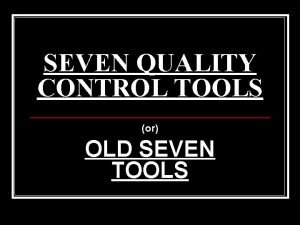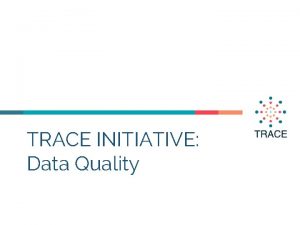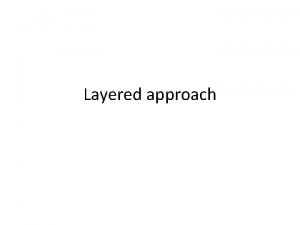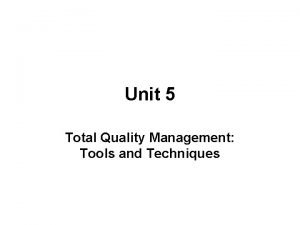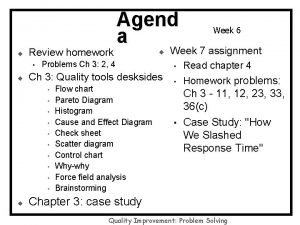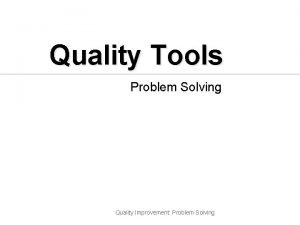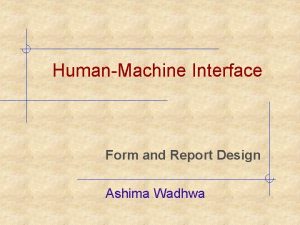Seven Quality Tools Ashima Wadhwa Seven Quality Tools






























- Slides: 30

Seven Quality Tools Ashima Wadhwa

Seven Quality Tools n n n n Cause and Effect Diagrams Flow Charts Checksheets Histograms Pareto Charts Control Charts Scatter Diagrams

Quality Tool Cause and Effect Diagrams

Fishbone Diagram Purpose: Graphical representation of the trail leading to the root cause of a problem How is it done? • Decide which quality characteristic, outcome or effect you want to examine (may use Pareto chart) • Backbone –draw straight line • Ribs – categories • Medium size bones –secondary causes • Small bones – root causes

Cause & Effect Diagrams Benefits: n Breaks problems down into bite-size pieces to find root cause n Fasters team work n Common understanding of factors causing the problem n Road map to verify picture of the process n Follows brainstorming relationship

Cause-and-Effect Diagram ( for error prevention ) Poor Tools Tight Scheduling Market pressure No version control Poor estimation skill No-debugger Hiring problem Lack of training Poor Programmers Programming Problems

Cause-and-Effect Diagram (a more “specific” example) wrong input data No input checking numerical overflow divide by zero error in computation Program terminates unexpectedly after input

Quality Tool Flow Charts

Purpose: Flow Charts Visual illustration of the sequence of operations required to complete a task ü ü Schematic drawing of the process to measure or improve. Starting point for process improvement Potential weakness in the process are made visual. Picture of process as it should be. Benefits: ü ü ü Identify process improvements Understand the process Shows duplicated effort and other non-value-added steps Clarify working relationships between people and organizations Target specific steps in the process for improvement.

Benefits • Simplest of all flowcharts • Used for planning new processes or examining existing one • Keep people focused on the whole process How is it done? • List major steps • Write them across top of the chart • List sub-steps under each in order they occur Flow Charts Top Down

Benefits n n n Show what actually happens at each step in the process Show what happens when nonstandard events occur Graphically display processes to identify redundancies and other wasted effort How is it done? n n Write the process step inside each symbol Connect the Symbols with arrows showing the direction of flow Flow charts Linear Toolbox

Quality Tool Checksheets

Purpose: Tool for collecting and organizing measured or counted data u Data collected can be used as input data for other quality tools u Benefits: Collect data in a systematic and organized manner u To determine source of problem u To facilitate classification of data (stratification) u Checksheets

Quality Control Tool Histograms

Histograms Purpose: To determine the spread or variation of a set of data points in a graphical form How is it done? : n n n Collect data, 50 -100 data point Determine the range of the data Calculate the size of the class interval Divide data points into classes Determine the class boundary Count # of data points in each class Draw the histogram Stable process, exhibiting bell shape

Histograms Benefits: • Allows you to understand at a glance the variation that exists in a process • The shape of the histogram will show process behavior • Often, it will tell you to dig deeper for otherwise unseen causes of variation. • The shape and size of the dispersion will help identify otherwise hidden sources of variation • Used to determine the capability of a process • Starting point for the improvement process

Quality Control Tool Pareto Charts

Purpose: Prioritize problems. How is it done? n Create a preliminary list of problem classifications. n Tally the occurrences in each problem classification. n Arrange each classification in order from highest to lowest n Construct the bar chart Pareto Charts

Pareto Charts Benefits: n n Pareto analysis helps graphically display results so the significant few problems emerge from the general background It tells you what to work on first

Quality Control Tool Control Charts

Control Charts Purpose: The primary purpose of a control chart is to predict expected product outcome. Benefits: n n n Predict process out of control and out of specification limits Distinguish between specific, identifiable causes of variation Can be used for statistical process control

Control Charts n n Strategy for eliminating assignable-cause variation: u Get timely data so that you see the effect of the assignable cause soon after it occurs. u As soon as you see something that indicates that an assignable cause of variation has happened, search for the cause. u Change tools to compensate for the assignable cause. Strategy for reducing common-cause variation: u Do not attempt to explain the difference between any of the values or data points produced by a stable system in control. u Reducing common-cause variation usually requires making fundamental changes in your process

Control Charts n Control Chart Decision Tree u Determine Sample size (n) u Variable or Attribute Data u t Variable is measured on a continuous scale t Attribute is occurrences in n observations Determine if sample size is constant or changing

Control Charts n n n Next, look at the upper and lower control limits. If your process is in control, 99. 73% of all the data points will be inside those lines. The upper and lower control limits represent three standard deviations on either side of the mean. Divide the distance between the centerline and the upper control limit into three equal zones representing three standard deviations.

Control Charts n Search for trends: u Two out of three consecutive points are in zone “C” u Four out of five consecutive points on the same side of the center line are on zone “B” or “C ” u Only one of 10 consecutive points is in zone “A”

Quality Control Tool Scatter Diagrams

Scatter Diagrams Purpose: To identify the correlations that might exist between a quality characteristic and a factor that might be driving it n A scatter diagram shows the correlation between two variables in a process. u These variables could be a Critical To Quality (CTQ) characteristic and a factor affecting it two factors affecting a CTQ or two related quality characteristics. n Dots representing data points are scattered on the diagram. u The extent to which the dots cluster together in a line across the diagram shows the strength with which the two factors are related.

Scatter Diagrams How is it done? : Decide which paired factors you want to examine. Both factors must be measurable on some incremental linear scale. • Collect 30 to 100 paired data points. • Find the highest and lowest value for both variables. • Draw the vertical (y) and horizontal (x) axes of a graph. • Plot the data • Title the diagram The shape that the cluster of dots takes will tell you something about the relationship between the two variables that you tested. •

• If the variables are correlated, when one changes the other probably also changes. • Dots that look like they are trying to form a line are strongly correlated. • Sometimes the scatter plot may show little correlation when all the data are considered at once. ü Stratifying the data, that is, breaking it into two or more groups based on some difference such as the equipment used, the time of day, some variation in materials or differences in the people involved, may show surprising results Scatter Diagrams

Queries?
 Ashima wadhwa
Ashima wadhwa Ashima wadhwa
Ashima wadhwa Benefits of technology absorption
Benefits of technology absorption Anita wadhwa
Anita wadhwa Neal wadhwa
Neal wadhwa Seema wadhwa
Seema wadhwa Seven tools of quality control
Seven tools of quality control The seven heavenly virtues mal
The seven heavenly virtues mal Seven dimensions of data quality
Seven dimensions of data quality Tools yang digunakan untuk prioritas maslah ialah
Tools yang digunakan untuk prioritas maslah ialah Quality metrics pmp
Quality metrics pmp Crosby's fourteen steps to quality improvement
Crosby's fourteen steps to quality improvement Define seminar in nursing management
Define seminar in nursing management What is tqm
What is tqm Quality assurance vs quality control
Quality assurance vs quality control Basic concept of quality control and quality assurance pdf
Basic concept of quality control and quality assurance pdf Compliance vs quality
Compliance vs quality Project quality management pmp
Project quality management pmp David a garvin 8 dimensions of quality
David a garvin 8 dimensions of quality Case tools and their effect on software quality
Case tools and their effect on software quality Quality control tools and techniques in project management
Quality control tools and techniques in project management Sqa tools and techniques
Sqa tools and techniques A quality focus in software engineering
A quality focus in software engineering Introduction to quality tools
Introduction to quality tools Quality management tools
Quality management tools Asq quality tools
Asq quality tools Quality management tools and techniques
Quality management tools and techniques Minitab quality tools
Minitab quality tools Quality tools
Quality tools Problem solving quality tools
Problem solving quality tools Sewing tools measuring tools
Sewing tools measuring tools






